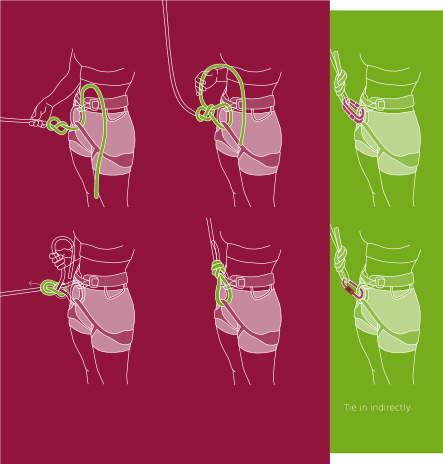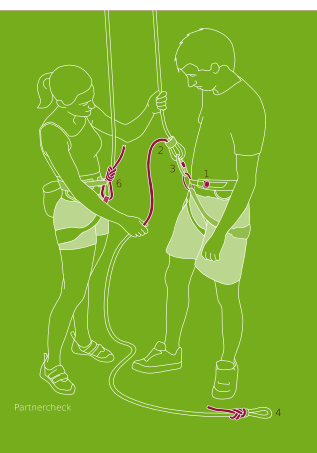Indoor Toprope
Introduction
In this document you will find all the course material for the toprope course. During the toprope course every new member will be taught the basics of climbing, this course is manditory for all new members. Besides that, you will also be made familiar with the most important rules and regulations regarding climbing at the TSAC. In total, the toprope course will take up three evenings. On the final evening there will be an examination. Furthermore, you have to be familiar with the theory and with the regulations at the TSAC. Aside from the theory in the NKBV‑booklet (Dutch) further on in this document, the TSAC has specific regulations regarding his own climbing walls.
NKBV Information Toprope
At TSAC we follow the course information of the Dutch national climbing association (NKBV). Since it is in Dutch we have translated the most important parts for you below. Not that this information is not stand-alone, proper instruction and supervision by a certified instructor is required to safely practice these techniques.
The Dutch booklet can be found here.

Tying in
There are two different ways to tie in; ‘direct’ with a figure-eight-follow-through knot (see Figure 1) and ‘indirect’ with karabiners. ‘Indirect’ can be done with one safebiner or two opposite locking karabiners. Never tie in on your gear loops, these can’t hold more than 10 kilograms!

Partner check
Figure 2 illustrates the steps in the partner check, check if:
- The harness is properly secured.
- The belay device is correctly installed.
- The karabiner for the belay device is screwed tight.
- The end of the rope is tied of.
- The climber is tied in correctly.
Remember that in the climbing world we also rely on social control, if you see somebody making a mistake you point it out or notify the attendant. Also be receptive if someone else points out your own mistakes.
Additional information
Belaying
The most commonly used type of belay devices are the so-called tubers. With tubers a rope bend is fed through the device and attached the your tie-in loop with a locking karabiner (through both the device and the rope bend). The rope end going to the climber should be on top, this is called the climbing end; the rope end on the bottom is called the breaking end. When belaying, always keep at least one hand on the breaking end of the rope, never let go! Below you can see the belay cycle:
|  |
It is better to take in small amounts of rope and repeat the steps more frequently than to take in large amounts of rope as it reduced the fall distance. Be careful not to have excessive slack in the rope. The weight difference between the climber and the belayer shouldn’t be more than 30%.
Assisted-breaking belay devices
Nowadays there are a lot of belay devices on the market that have an assisted breaking function. You are allowed to use these devices at the TSAC as long as you, your climbing partner and the zaalwacht are all familiar with its use.Do note that not every belay device operates in the same manner and that you should always follow the instructions in the manual. Though in all cases you should always keep your hand on the breaking end of the rope, regardless of the device used, because you can't always rely on the breaking function to work properly:
At the end of this article there are instructional movies in English about the correct usages of several common belay devices. And remember: the belayer is responsible for the safety of the climber, not the belay device.
Climbing on the TSAC walls
The TSAC is fortunate to have access to four beautiful climbing walls at the sport centre, allowing you – after passing your toprope exam – to climb to your heart’s content. Each wall has its own rules regarding its use, all of which are described in the relevant wall regulations. Of course you can always just ask somebody about the rules.
General rules and some rules specific to the concrete wall are presented below:
- To prevent injuries, remove all types of jewellery and accessories etc. before you start climbing.
- Never put your fingers through the metal bolt hangers (short: bolts) or in the holes of the brick walls! If you fall, there is a chance that you will lose your fingers. The bolts are meant to be used for hanging in quickdraws during lead climbing and should not be used for pulling yourself up or to stand on. If you want some aid, hang a quickdraw or a sling in the bolt and grab the webbing to pull yourself up, don’t use karabiners or other metal objects.
- There is a metal ladder on the right side of the concrete wall. You can use it to easily reach the top of the wall to, for example, hang out a toprope. Caution, don't fall down! Also, you can easily bump your head.
- Always tie in using a figure 8 follow‑through knot.
- On the left of the wall, there is a dent in the tube, this part is marked with white and red tape. You cannot put a rope around the taped part. Use both carabiners connected by means of a sling to the rings hanging on the left and right of the taped part to put the rope through.
- When you start a toprope in the middle section of the plastic wall, make sure the last three quickdraws in the ceiling are clipped in. If you are climbing in the ceiling and your feet are no longer on the vertical wall, you have to unclip the quickdraw in the corner. Remember to clip it back in before going down.
- When bouldering on the concrete wall you are not allowed to place your feet above the first horizontal seam.
- Never stand on the rope. Small rocks or grains of sand can get through the sheath and damage the core. Incidentally, any inconsistencies in or damage to the rope should be reported immediately to the supervising instructor.
- To prevent the rope from getting tangled up (very inconvenient during climbing!) the rope has to be coiled neatly after use. There are several ways to coil your rope but the TSAC uses the French method (i.e. butterfly coil tied off with a gasket hitch). Make sure you tie the hitch firmly so that the coil will not fall apart. If everybody pays attention to coiling the rope properly, you can always grab a rope from the shelf, tie in and start climbing immediately. It’s just annoying if you have to flake the rope before you can start climbing.
Finally, during the regular climbing evenings there is always 1 supervising instructor tasked with guarding everybody’s safety: the attendant (Dutch: "zaalwacht"). Any command from him/her needs to be obeyed.
Should you ever break one of these rules and the attendant catches you, you will have to buy him/her a drink in the canteen!
Qualifications per climbing certification
My certificate | I'm allowed to |
|---|---|
KVB-IT | Toprope at the Sports Centre when an attendant is present |
KVB-IV | Do everything you're allowed to with a KVB-IT and:
After passing the theory exam:
|
KVB-OV | Do everything you're allowed to with a KVB-IV and rappelling |
KVB-OV-MP or higher | Do everything you're allowed to with a KVB-OV and multi-pitch on the TSAC walls with other persons with a KVB-OV-MP. |
